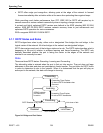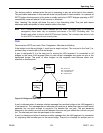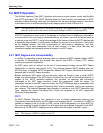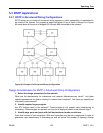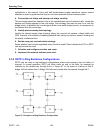
Spanning Tree
RS400 141 ROS™ v3.5
5.2.3 Benefits of MSTP
Despite the fact that MSTP is configured by default to arrive automatically at a spanning tree
solution for each configured MSTI, advantages may be gained from influencing the topology of
MSTIs in an MST region. The fact that the Bridge Priority and each port cost are configurable
per MSTI (see sections 5.4.4 and 5.4.5) makes it possible to control the topology of each MSTI
within a region.
Load Balancing
MST can be used to balance data traffic load among (sets of) VLANs, enabling more complete
utilization of a multiply interconnected bridged network.
A bridged network controlled by a single spanning tree will block redundant links by design, in
order to avoid harmful loops. MSTP blocks not the entire port, but instead per VLAN per port,
which means that a port that is blocked to one set of VLANS may still pass traffic from other
VLANs.
It is possible to control the spanning tree solution for each MSTI, especially the set of active
links for each tree, by manipulating, per MSTI, the bridge priority and the port costs of links in
the network. If traffic is allocated judiciously to multiple VLANs, redundant interconnections in a
bridged network which, using a single spanning tree, would have gone unused, can now be
made to carry traffic.
Isolation of Spanning Tree Reconfiguration
A link failure in an MST region that does not affect the roles of Boundary ports will not cause the
CST to be reconfigured, nor will the change affect other MST regions. This is due to the fact that
MSTP information does not propagate past a region boundary.
MSTP versus PVST
An advantage of MSTP over the Cisco Systems Inc. proprietary PVST protocol is the ability to
map multiple VLANs onto a single MSTI. Since each spanning tree requires processing and
memory, the expense of keeping track of an increasing number of VLANs increases much more
rapidly for PVST than for MSTP.
Compatibility with STP and RSTP
No special configuration is required for the bridges of an MST region to connect fully and simply
to non-MST bridges on the same bridged network. Careful planning and configuration is,
however, recommended in order to arrive at an optimal network.




